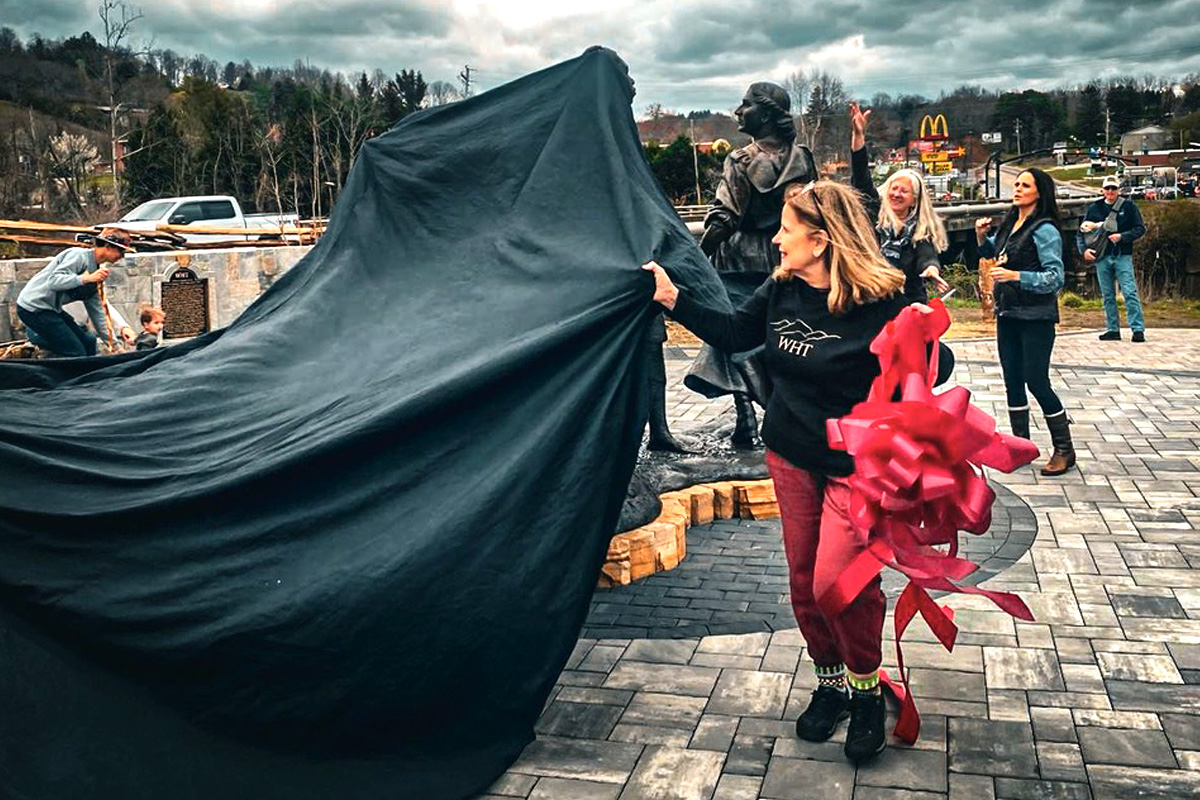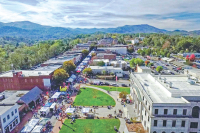'Sowing the Seeds of the Future': New sculpture unveiled on Franklin's Women's History Trail
 Leaders of the Women’s History Trail uncover the new sculpture at the Women’s History Park. Hannah McLeod
Leaders of the Women’s History Trail uncover the new sculpture at the Women’s History Park. Hannah McLeod
Overcast skies didn’t deter a large crowd from coming out to witness the unveiling of the sculpture “Sowing Seeds of the Future,” on Saturday, March 23, in downtown Franklin.
“This is a historic occasion that we celebrate today, one that will go down in history as we come together and celebrate this monument and this place here in Franklin,” said Franklin Mayor Jack Horton. “It’ll welcome visitors and give them a sense of our history and our culture while emphasizing the critical role that women have played in the development and sustaining the character of this place that we all call home.”
A crowd of hundreds gathered Saturday morning to celebrate Women’s History Month with the reveal of the latest addition to Franklin’s Women’s History Trail and the opening of the Women’s History Park, located at 592 East Main St.
In addition to members of the Folk Heritage Association of Macon County who worked to secure the statue, sculptor Wesley Wofford and his wife, Odyssey, dignitaries in attendance included Sen. Kevin Corbin (R-Macon), Rep. Karl Gillespie (R-Macon), Commission Chairman Gary Shields, past Commissioner Ronnie Beal, Mayor Horton and other staff and council members from the town.
“Our staff are very dedicated to this project,” said Horton in his remarks. “It’s great to see this come together at this time.”
The director of Gov. Roy Cooper’s Western Office, Drew Christy, was also in attendance to offer a message from First Lady Kristen Cooper.
Related Items
“The 2024 National theme for Women’s History Month is women who advocate for equity, diversity and inclusion, which recognizes women in every community who have devoted their lives to embracing everyone in the community under the common quest for freedom and opportunity,” said Christy.
The “Sowing the Seeds of the Future” sculpture is part of the Women’s History Trail, both of which were conceptualized by Macon County resident Barbara McRae. McRae was a journalist, historian, naturalist, visionary and trailblazer. She had a particular interest in researching the lives of significant Macon County women whose accomplishments and influences had been unknown or forgotten.
“She was quite a visionary leader,” Horton said of McRae. “And she would be very, very proud of this occasion that we’re celebrating today.”
In 2017, McRae met Wofford, and the encounter sparked the creation of “Sowing the Seeds of the Future.” McRae had been thinking about the interconnected lives of Na-Ka Rebecca Morris, a Cherokee woman, Harriet Timoxena Siler Sloan, a pioneer woman, and Salley, an enslaved woman, all linked by a specific piece of property on the Little Tennessee River.
McRae tried to imagine what their everyday lives might have been like in early-19th-century Franklin, and Wofford embraced the challenge of bringing them to life in a work of art.
In May 2018, Wofford presented a miniature prototype of what would become “Sowing the Seeds of the Future” to the Folk Heritage Association of Macon County, and he was commissioned to go ahead with the sculpture.
The Folk Heritage Association of Macon County sponsored the creation of the Women’s History Trail and raised funds for the new sculpture. It officially transferred the sculpture to the Town of Franklin on Saturday in honor of Women’s History Month. The sculpture not only represents three historical women, but also symbolizes each group of women and their cultural contributions that helped forge Franklin.
“I’m the collaborative contributor that had a message funneled through my skill set into that statue,” said Wofford. “It’s the honor of my life to work with the black community, this group of women, the Cherokee Nation and Barbara McRae.”
The three women represented in the sculpture are all touching hands, a position that, according to the artist statement, is supposed to illustrate the sisterhood of women that transcends cultural divides.
“It celebrates women’s contributions, inspires current and future generations of girls and women to pursue their dreams, and challenges us all to learn from the past and aspire for a more equitable future,” the artist statement reads.
Na-Ka Rebecca Morris (1793-1885), a Cherokee woman and niece of a prominent chief of the Oconaluftee Cherokees, married Baptist minister and farmer Gideon Morris of South Carolina in the early 1800s. In the Treaty of 1819, the pair obtained a preserve of 640 acres along the Little Tennessee River in what is now East Franklin. The land bordered the Nikwasi Village and Mound.
After the family was burned off their land by white settlers, they received compensation from the state and moved across the river into the new town of Franklin.
Salley, born into slavery in 1799, is the bridge between Na-Ka Rebecca Morris and Harriet Timoxena Siler Sloan (1835-1900), as she learned from the Cherokee and was a presence in Na-Ka Rebecca’s life before being sold to Harriet’s father. Harriet and her husband had seven children and lived in an area by the Little Tennessee River near the property originally owned by Na-Ka Rebecca and her husband.
Harriet appears in the statue twice, once as a child on Sally’s hip, receiving corn from Na-Ka Rebecca, and again as a grown woman striding into the future.
All three women are thought to have played a vital role in the early history of Franklin.
“There is nothing like seeing those ladies in person,” said Marty Greeble, a member of the Women’s History Trail leadership. “When you look at them, you are going to be mesmerized and it will change your life. I absolutely believe that.”









